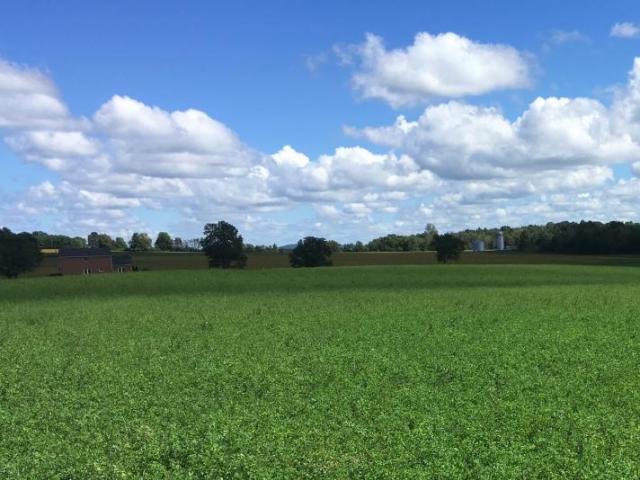
Alfalfa Field
By Mark Sulc, OSU Extension
Fall is a great time to take care of some very important aspects of managing forage hayfields and pastures. Below is a list of things that when done in the fall can help avoid big headaches this winter and next spring or even next summer.
- One of the most important things to do now is to pull soil samples and get a soil test. Ask for the 2020 Tri-State Fertility Recommendations to be applied to the results. Apply fertilizer to correct any soil deficiencies and replace nutrients that were removed in hay and silage. Fall is a great time to apply both P and K to prepare established forage stands for winter. Soil sampling and testing are especially critical in preparation for making new forage seedings next spring or summer. Now is the time to apply lime to raise low soil pH levels for next year’s seedings. Soil preparation now will also help you be ready to plant when the first break in the weather comes next spring. Many headaches with forage stands can be greatly alleviated with proper fertility levels. Deficient fertility leads to weak forage stands that are susceptible to stresses (including winter injury) and especially weed invasion. Links to additional soil fertility resources can be found at https://forages.osu.edu/forage-management/soil-fertility-forages.
- Scout hayfields and pastures for current and emerging weed problems. Most perennial, biennial, and winter annual weeds are much easier to control now in the fall than next spring. A good example is cress leaf groundsel, as discussed by Mark Loux recently (https://agcrops.osu.edu/newsletter/corn-newsletter/2020-30/scout-now-cressleaf-groundsel-hayfields-or-pay-price-may). Some herbicides are best applied in October, while others have to apply as dormant applications during the winter. Scouting now will help you determine the major weed problems and consequently when is the best time for corrective action. But remember the first point above. If the soil is deficient, chemical weed control will have at best a temporary effect.
- Harvest or take final grazing of summer annual grasses now before frost events begin. This is especially important for peace of mind regarding the worries of prussic acid poisoning potential associated with forages in the sorghum family. For more details about the effect of maturity on yield and nutritive value of summer annual grasses see https://forages.osu.edu/news/harvest-management-summer-annual-grasses. For details about frost injury and late-season forage, concerns see https://forages.osu.edu/news/be-alert-late-season-potential-forage-toxicities.
- Continue to allow a fall rest period for forage stands, especially legumes. For more detail see https://agcrops.osu.edu/newsletter/corn-newsletter/2020-28/late-season-forage-harvest-management.
- Avoid overgrazing pastures in the fall. Grasses like legumes need to accumulate energy reserves for the winter, and they need plenty of leaf area to accomplish that. Light grazing or even resting pastures completely in the fall will ensure more vigorous stands next spring. Stockpiling pasture growth from late summer through the fall for winter grazing is a good way to allow the plants to prepare for winter, while also providing forage for winter grazing rather than having to feed so much hay during cold weather.
- An exception to the above rule is where you want to frost seed legumes into pastures. In that case, you should overgraze the pasture hard enough so that patches of soil are exposed. And if it grows back before winter, graze it hard again! This will weaken the grass sod and open spaces to allow good seed-soil contact for the legume seed to be broadcast late winter. Overgrazing through the fall will also weaken the grass competition next spring when the legumes are beginning to establish.
- Prepare fencing and water supply needs for grazing corn stover after grain harvest is complete. Corn stover is an especially useful resource for beef cattle. For more details on grazing corn stover see https://u.osu.edu/beef/2019/11/20/corn-stalks-provide-another-grazing-option/
- Plan fencing and water supply need for winter strip grazing of stockpiled pastures and annual cover crops are sown this summer into wheat stubble or fall-planted into corn silage stubble. Strip grazing will improve the utilization of those forages in late fall and into the winter months.
- Make logistical plans for winter feeding of hay. This might involve distributing bales around the winter pasture area. This type of placement can be strategically used with strip grazing to build up soil fertility with manure from livestock during winter feeding on pasture.
- Collect core samples from hay, haylage bales, and silage and have them tested for nutritive value in preparation for winter feeding. This will inform your livestock supplementation needs when you begin feeding the hay.
I realize fall is a very busy time for most of us. But taking care of these items now will only help make things smoother and more successful down the road.